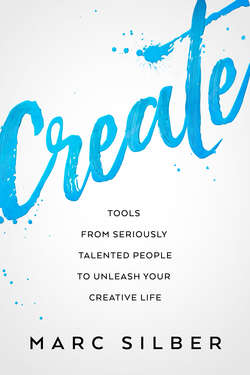Читать книгу Create - Marc Silber - Страница 11
На сайте Литреса книга снята с продажи.
ОглавлениеLeave Room in Your Cup
I have told this story at the start of my workshops:
Nan-in, a Japanese master, received a university professor who came to inquire about his teachings.
Nan-in served tea. He poured his visitor’s cup full, and then kept on pouring.
The professor watched the overflow until he no longer could restrain himself. “It is overfull. No more will go in!”
“Like this cup,” Nan-in said, “you are full of your own opinions and speculations. How can I teach you unless you first empty your cup?”
I encourage you to come to this book with an empty cup. If a new idea won’t quite flow in, check to see if you need to make a bit more room in your cup.
Take Pleasure in the Joy of Understanding
“The noblest pleasure is the joy of understanding.”
—Leonardo da Vinci
My parents instilled a deep respect for understanding words and their derivations by encouraging me to use dictionaries. My mom’s mantra was to always look up any word you didn’t understand as soon as you encountered it; to never try to slip past one, or you wouldn’t experience the joy of understanding.
In addition to using a good dictionary (I recommend the Oxford Concise which also comes in a very handy smartphone app.) You can also Google “define _____”—but watch out, some of these start simple but soon get more complex. So grab what you need to understand the word and don’t dive in the deep end.
Be Fully Involved
“Tell me and I forget. Teach me and I remember.
Involve me and I learn.”
—Benjamin Franklin
Another point I cannot stress enough: get fully involved with what I’m discussing with you as soon as you encounter it. Look at how it applies to you and your life and find real scenarios. For example, when I’m discussing tools for creativity, take a moment to locate yours, so you have solid examples. They might be kitchen knives, or a musical instrument, or wood working tools—whatever they are, connect what I’m discussing with them. This is vital to bring about positive changes.
Part of being involved is setting a schedule to study and work with this book, ideally daily, but at least weekly. Whatever you set, stick to it. Try to get in at least three hours a week which could be a little as twenty-five minutes a day. Not a bad investment to bring on a new creative life.
Track Your Stray Thoughts
“Keep a notebook. Travel with it, eat with it, sleep with it. Slap into it every stray thought that flutters
up into your brain. Cheap paper is less perishable
than gray matter, and lead pencil markings endure
longer than memory.”
—Jack London
I love notebooks (they have long been a staple for artists) and I want you to get one and write in it daily. It helps to use it for visual thinking to sketch or write down your discoveries, key words you want to remember, diagrams and drawings of how something works, and flashes of inspiration and “stray thoughts.” I write my realizations in a notebook daily so that I can keep track of what I’m learning and accomplishing and to face up to areas I need to master.
Your first assignment is this: get a notebook and use it daily while you go through this book. Write in it, draw, explore your ideas, make notes, ask questions, diagram and learn.
What to Expect as You Learn
The shape of the book is this: I’ll discuss the tools that I want you to be familiar with and give you examples of their use. Interspersed between the chapters are my interviews with a wide variety of creative people telling their stories about how they’ve transformed their lives. As you’ll see, we have a very eclectic mix of artists, Grammy award-winners, a serial entrepreneur who grew up homeless on the streets, the voice of Bart Simpson, and many others who help us round out the book.
At the end of each chapter I’ll ask you summarizing questions about what we covered so that you have an opportunity to look at how you can apply these points to your life. I’d like to you feel as though I’m right there helping you become involved and owning what we’ve covered. Use these moments as a chance to take the given concept and do something with it: reflect, imagine applications, use it to analyze a given personal or unique situation.
If you cannot easily do so then review that section of the book until you can apply it. But don’t treat these as “tests.” Rather, use them as an opportunity to really dig in, get involved, and arrive at the “joy of understanding.”
Next, I’ll give you application steps to put these tools into use. These are designed to help transform your life to a higher level of creativity. And just as in climbing a tall mountain, you’ll get to the top one step at a time.
In both the summarizing and application steps, I’ll be asking you for excuses, justifications, procrastinations, etc. in order to bring them into the fresh air and peel them off like a snake sheds its skin. Take this opportunity to dig deep and rid yourself of these barriers, so that you can take action, which is the whole point of this book.
To set the tone of the book and your work with it, I don’t want you to feel like it’s supposed to be a hard or solemn experience. Quite the opposite—you should find yourself being more lighthearted and joyful about life as you progress through the book.
Let’s make this climb together and arrive at a whole new view; a whole new way of living as art.
Be sure to go to SilberStudios.com/Create-Resources for additional resources as you read the book.
